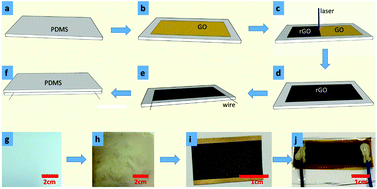High performance flexible strain sensor based on self-locked overlapping graphene sheets
Abstract
Strain sensors have been widely used in the fields of wearable devices, robot arms, medical sensing, bio-sensing, artificial skin and so on, but the existing strain sensors have some shortcomings such as a limited gauge factor (GF) or strain range. We fabricate a novel and flexible strain sensor with high performance based on self-locked overlapping graphene sheets (SOGS) which can be used for wearable devices. Polydimethylsiloxane (PDMS) is used to lock the overlapping graphene sheets, and then the graphene can be stretched and achieve an ultrahigh GF. In addition, a new theory is put forward to explain the GF changes with strain range for the SOGS strain sensor. In this work, graphene oxide (GO) film is reduced to reduced GO (rGO) by a laser. Then, the SOGS and electrodes are encapsulated by PDMS. The SOGS strain sensor has a high GF up to 400 and strain range over 7.5%, and this SOGS strain sensor achieves a balance between high sensitivity and large strain range compared with other existing strain sensors. Furthermore the theoretical equation based on the new theory agrees well with the experimental results. And this strain sensor can be used in many applications because of its high sensitivity. Some applications of the SOGS strain sensors are demonstrated for the detection of various human motions and human sounds. The SOGS strain sensor can exhibit great potential in wearable electronics because of its good balance between high sensitivity and large strain.


 Please wait while we load your content...
Please wait while we load your content...